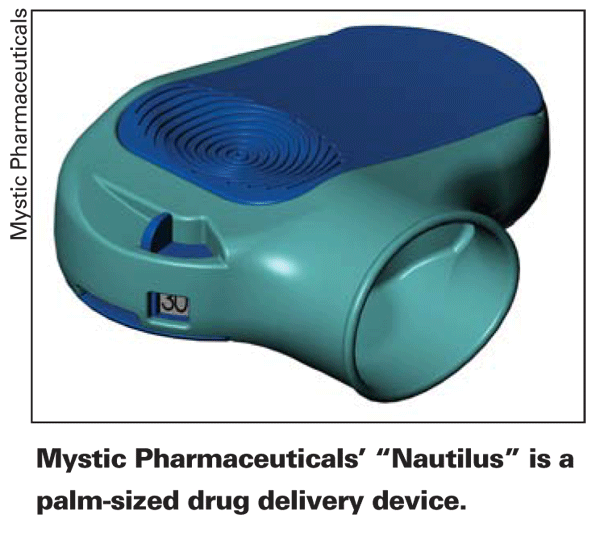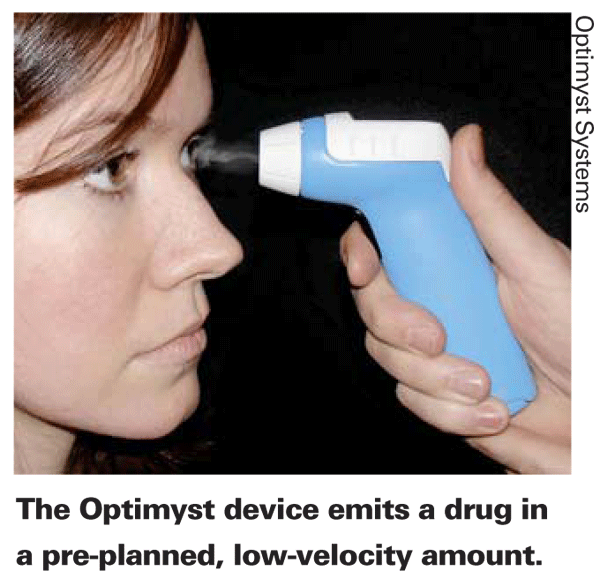Few things are as hard to dislodge as an ingrained idea; everyone just accepts it and moves on. And there are few ideas as ingrained as that of using eye drops for treating ophthalmic disease. However, to some companies and researchers, there's no idea that's in greater need of rethinking than the eye drop. To these individuals, eye drops are wasteful, prone to overdosing and may be even hazardous to someone's health, depending on the medication being instilled.
Here's a look at these companies' attempts at re-engineering the traditional eye drop:
• Mystic Pharmaceuticals' Versadosers. Timothy Sullivan, chief executive officer of Mystic Pharmaceuticals, thinks the system of delivering drug to the eye is in need of improvement. "In order for gravity to pull a drop off of the bottom of a bottle, it has to get up to around 40 µL of volume," he says. "But the carrying capacity of the eye is only about 12 µL, so you're always overdosing." He says when you combine this with the challenge to an elderly person's dexterity of having to accurately drop the liquid into his eye, and the waste involved with the multiple attempts, "you can run up a significant number for wasted medicine."
He also says a steady overdose of the wrong medicine could be undesirable. "The excess can flow down the nasolacrimal duct, down the throat and into the gut," he explains. "And, if it's a beta-blocker that you're chronically overdosing, you could incur systemic side effects that could be eliminated with precision dosing." There can also be cosmetic effects associated with overspray of drug, such as blepharitis, allergic reactions and the propensity for some prostaglandins to stain the skin if they constantly run down the face.
Mystic's alternative is to package a drug aseptically in a unit dose blister pack. The company then packages those blisters in delivery devices that don't rely on gravity to deliver medicine. "If you need 12 µL, we can deliver it," says Mr. Sullivan. To use the device, the patient places an eye-guide, which serves to hold the lid open as well as establish a standard distance from the device, and presses a trigger. Hand/head orientation doesn't matter.
"The device turns the drug into a coherent stream of droplets, with the device operating in a way similar to the operation of a positive displacement pump," explains Mr. Sullivan. "In a syringe of liquid, for example, once you get the air out, when you compress the syringe the liquid is forced out. In our blisters, each one has a component called a velocity jet, which allows the blister to function as a positive displacement micro-pump. So, when you apply a certain amount of pressure to it, the drug flows through the micro-pump and into the eye. It comes out as a gentle stream of droplets that's barely perceptible to the recipient."
The system is entering Phase III clinical trials this year, and Mr. Sullivan expects it to be available in mid to late 2009. "It will be available through Mystic, containing two ophthalmic products, a glaucoma product and a dry-eye product," says Mr. Sullivan. "We're also working with a number of ophthalmic drug makers, and we expect it will ultimately be available through them with their drugs, as well."
In terms of specific designs, the company is developing different devices for different users. There's an ophthalmic delivery device that's aimed at women and looks like a cosmetic appliance; a device that's made to be easy to grasp and operate for elderly users and the ophthalmic "Nautilus," which can come in a disposable form, with as many as 120 doses of a medicine, and a reloadable version. The Nautilus is palm-sized.
• Optimyst Systems mist device. The Optimyst device is a small (4.5 inches by 1 inch) ultrasonic nebulizer, similar to the devices used by asthmatics. Inside is a sterile mini-dropper bottle of 1 ml of medicine. To use the device for self administration, the patient places the mister's small spacer on his cheekbone, which ensures a proper working distance, then pulls a trigger. The trigger activates a tiny piezoelectric chip and transducer that causes the gadget to emit a drug in a pre-planned, low-velocity amount. "The duration of emission is independent of how long you hold down the trigger," says James Collins, MD, the device's developer. He envisions three models of the device: a typical battery-operated system, as described above, that might be used by a glaucoma patient; a second that would be rechargeable for use in a doctor's office and a third, smaller unit that would fit in a pocket and be used for simple over-the-counter solutions such as artificial tears.
The average unit would probably be designed to deliver between 5 and
10 µl of fluid volume per trigger pull. "That's sort of the 'holy grail' delivery amount seen throughout the literature," says Dr. Collins. "It's large enough to have a clinical effect, even at standard concentrations, but small enough to mix with the tear film for enough time to work without being washed out quickly as a larger volume might. It also is small enough to avoid irritating the lids and lid margins from all of the drug washout and it minimizes the amount of drug presented to the systemic circulation via nasolacrimal duct drainage."
Some more research is in store for the Optimyst device. "Our next studies will involve the fourth generation of the device, with which we're looking to do at least three more clinical trials of 50 to 100 patients each using different medications, such as anesthetics and anti-infective agents," says Dr. Collins. "The FDA has told us this will be a 505(b)(2) process, in which you get approval on a per-medication basis for existing drugs, essentially 'bioequivalent' to the reference listed product in drop form." 
Dr. Collins says the biggest challenge may not be making the device, but getting the world to accept it, or any device like it. "You have to deal with the equilibrium of the eye-care industry," he says. "There's the challenge of trying to introduce this into an extremely established, equilibrated market where everything revolves around the traditional eye drop-based drug delivery vehicle. Just because something may be better, safer and easier to use is no guarantee that the system can embrace and accept it. We'll be happy to have this device fill some 'niche needs.' There's a lot more to be worked out in terms of cost and other practical concerns before we can expect any kind of widespread adoption."
• QLT's drug inserts. Taking a different tack, QLT is developing punctal plugs that can be used as anchors for delivering drugs in minute quantities over time to the tear film. The modality uses a proprietary plug design and drug elution technology to try to deliver a drug over 90 days. The insert could be placed in the lower punctum in patients with dry eye to help keep tears on the eye, or in the upper for non dry-eye patients so as not to affect tear drainage.
"Our initial efforts will be targeted at glaucoma," says Robert Butchofsky, QLT's CEO. "We'll be filing the investigational new drug application in the first quarter of 2008, and will be in clinical studies in the first half of the year. We expect to generate data before the end of 2008 in glaucoma patients. We're looking at a number of different compounds for use in the inserts. Our platform can use medications that are coming off patent or it can contain proprietary medications."
Mr. Butchofsky hopes that the inserts will help tackle one of the main problems with glaucoma treatment: non-compliance. "We think this is an elegant solution for patients with a chronic disease that, instead of putting patients in a position to take drops each day, would only require them to go to the doctor quarterly, get their intraocular pressure checked, remove the old punctal plug and have a new one inserted," says Mr. Butchofsky. "So they may only have to worry about their glaucoma four times a year." He hopes that by eluting minute quantities of drug over time, the inserts will avoid problems with burning, stinging or systemic absorption of drug that can occur with the larger quantities delivered in drop form.



